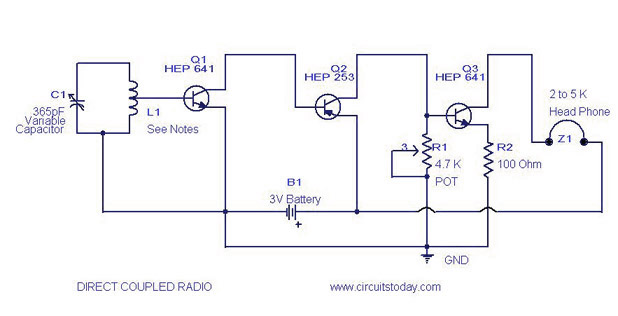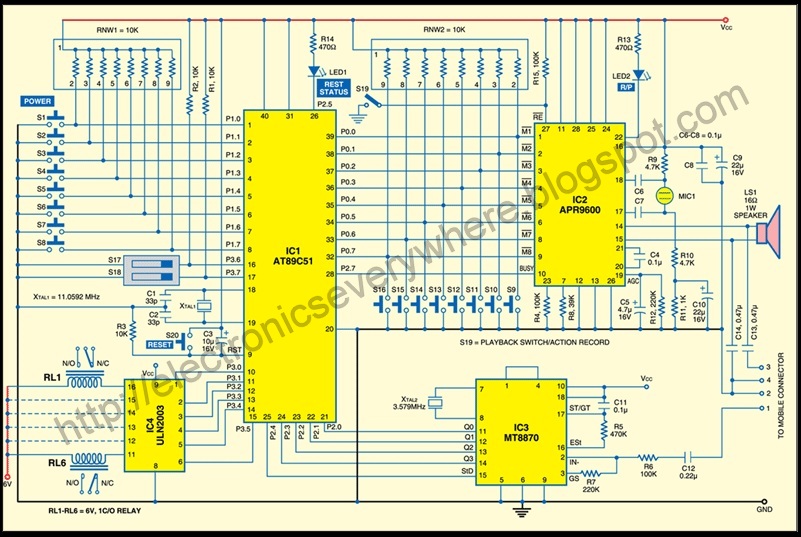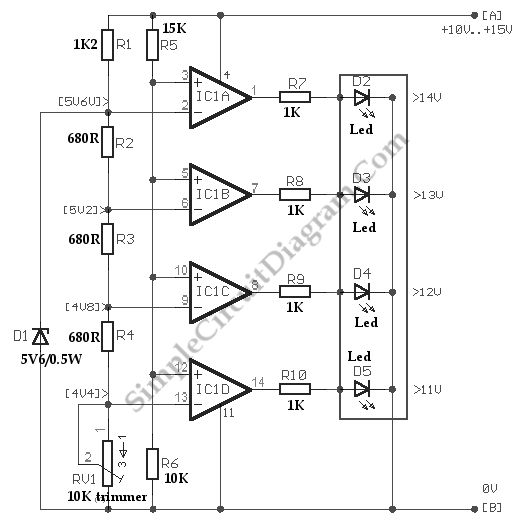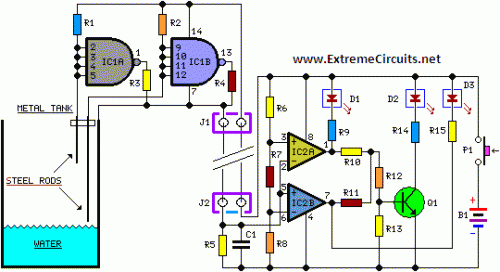
VU LED Indicator Schematic
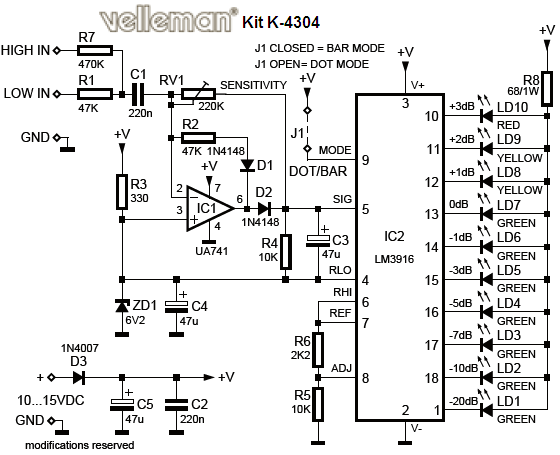
The VU LED indicator is simpler and smaller than its analog counterparts and is commonly used in audio equipment. This version is based on a National Semiconductor integrated circuit (IC) that utilizes a logarithmic response. Each LED operates with a 3 dB difference from the previous one, and a jumper is provided to select between dot or bar mode. The circuit follows conventional designs based on application notes from National Semiconductor. It can be constructed using a single IC and a few discrete components. The direct current (DC) supplied to the LED is nearly filtered, with capacitor C1 included to prevent oscillation in the IC, although it does not serve as a filter capacitor. This design allows for a higher LED current with lower dissipation compared to fully refined DC, which would necessitate larger capacitors, increasing both size and cost—particularly relevant for applications in mixers or analyzers where bulk production may occur. The setup is straightforward. At the maximum operating level desired (as indicated by an audio millivoltmeter or oscilloscope with an applied signal), adjust variable resistor VR1 so that all the green LEDs are illuminated (L1 is the most sensitive, and L10 indicates the maximum level, so L1 through L8 should be lit). If the input is taken directly from the speaker output, an additional series resistor should be employed at the "Aud" input to lower the level. This resistor value can be determined through calculation or experimentation; as a guideline, for a 50W amplifier, an external resistance of approximately 47k ohms is recommended. When calibrating the meter for the power amplifier, set the output to a level below clipping. Adjust the level control until the LED lights up. This way, if the L10 LED is illuminated while listening to music, it indicates that the system is close to clipping, suggesting that the volume should be reduced.
The VU LED indicator circuit is designed to provide a visual representation of audio signal levels, enabling users to monitor the output levels effectively. The circuit employs a logarithmic scale to ensure that the LED responses correspond to human auditory perception, where a logarithmic relationship exists between sound intensity and perceived loudness. The use of a single IC simplifies the design and reduces component count, which is advantageous for both space and cost considerations.
The inclusion of a variable resistor (VR1) allows for fine-tuning of the LED response, ensuring that the visual indicators accurately reflect the audio signal levels being processed. The green LEDs (L1 to L10) are arranged in a sequential manner, with L1 being the lowest level indicator and L10 representing the maximum level. This arrangement provides a clear visual cue to the user regarding the signal strength.
The circuit's ability to operate in either dot or bar mode, selectable via a jumper, enhances its versatility, allowing it to be configured according to user preference or specific application requirements. The design also accommodates variations in input signal levels, particularly when interfacing directly with speaker outputs. The recommended use of a series resistor at the "Aud" input ensures that the circuit remains within operational limits, preventing potential damage to the LEDs or the IC itself.
In summary, this VU LED indicator circuit is an efficient and effective means of monitoring audio signal levels, utilizing a straightforward design that is both compact and cost-effective, making it suitable for various audio equipment applications.VU LED indicator is simpler and smaller than their analog, and very common in audio equipment. This version is based on National Semiconductor IC, and using the logarithmic version. Each LED operates with a 3dB difference from before, and the jumper is provided to allow dot or bar mode. The circuit is completely conventional, and is based on application notes from National Semiconductor. The circuit is shown in the picture below and you can view it with a single IC and some discrete components. DC to the LED is almost filtered - C1 are included to ensure that the IC does not oscillate, and is not a filter cap.
This allows a higher LED current with lower dissipation than is the case if the DC is fully refined, and full smoothing would also require much larger capacitors. This will increase the size and cost of the project - especially important if you want to use in larger quantities that may occur with a mixer or analyzer.
It could not be simpler. At the maximum level that you want to operate the equipment (as shown on the audio millivoltmeter or an oscilloscope with a signal applied), adjust VR1 so that the signal light to all the green LED (L1 is the most sensitive, and L10 showed the maximum level, so L1 to L8 should be lit ). If the input directly from the speaker output, an additional series resistor should be used in terminal "Aud" input to reduce the level.
This can be determined by calculation (I leave it to you) or by experiment. As a guide, for 50W amplifier, an external resistance should be about 47k ohms. If you calibrate the meter for the power amplifier, set the output to a level below clipping. Adjust the level control until the LED turns on. In this way, if (L10) LED bulbs last when you`re listening to music, you`ll know that you are very close to clipping, and volume should be reduced. 🔗 External reference
The VU LED indicator circuit is designed to provide a visual representation of audio signal levels, enabling users to monitor the output levels effectively. The circuit employs a logarithmic scale to ensure that the LED responses correspond to human auditory perception, where a logarithmic relationship exists between sound intensity and perceived loudness. The use of a single IC simplifies the design and reduces component count, which is advantageous for both space and cost considerations.
The inclusion of a variable resistor (VR1) allows for fine-tuning of the LED response, ensuring that the visual indicators accurately reflect the audio signal levels being processed. The green LEDs (L1 to L10) are arranged in a sequential manner, with L1 being the lowest level indicator and L10 representing the maximum level. This arrangement provides a clear visual cue to the user regarding the signal strength.
The circuit's ability to operate in either dot or bar mode, selectable via a jumper, enhances its versatility, allowing it to be configured according to user preference or specific application requirements. The design also accommodates variations in input signal levels, particularly when interfacing directly with speaker outputs. The recommended use of a series resistor at the "Aud" input ensures that the circuit remains within operational limits, preventing potential damage to the LEDs or the IC itself.
In summary, this VU LED indicator circuit is an efficient and effective means of monitoring audio signal levels, utilizing a straightforward design that is both compact and cost-effective, making it suitable for various audio equipment applications.VU LED indicator is simpler and smaller than their analog, and very common in audio equipment. This version is based on National Semiconductor IC, and using the logarithmic version. Each LED operates with a 3dB difference from before, and the jumper is provided to allow dot or bar mode. The circuit is completely conventional, and is based on application notes from National Semiconductor. The circuit is shown in the picture below and you can view it with a single IC and some discrete components. DC to the LED is almost filtered - C1 are included to ensure that the IC does not oscillate, and is not a filter cap.
This allows a higher LED current with lower dissipation than is the case if the DC is fully refined, and full smoothing would also require much larger capacitors. This will increase the size and cost of the project - especially important if you want to use in larger quantities that may occur with a mixer or analyzer.
It could not be simpler. At the maximum level that you want to operate the equipment (as shown on the audio millivoltmeter or an oscilloscope with a signal applied), adjust VR1 so that the signal light to all the green LED (L1 is the most sensitive, and L10 showed the maximum level, so L1 to L8 should be lit ). If the input directly from the speaker output, an additional series resistor should be used in terminal "Aud" input to reduce the level.
This can be determined by calculation (I leave it to you) or by experiment. As a guide, for 50W amplifier, an external resistance should be about 47k ohms. If you calibrate the meter for the power amplifier, set the output to a level below clipping. Adjust the level control until the LED turns on. In this way, if (L10) LED bulbs last when you`re listening to music, you`ll know that you are very close to clipping, and volume should be reduced. 🔗 External reference
Warning: include(partials/cookie-banner.php): Failed to open stream: Permission denied in /var/www/html/nextgr/view-circuit.php on line 713
Warning: include(): Failed opening 'partials/cookie-banner.php' for inclusion (include_path='.:/usr/share/php') in /var/www/html/nextgr/view-circuit.php on line 713
